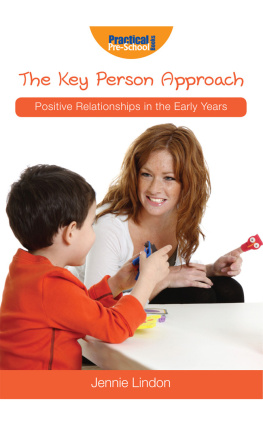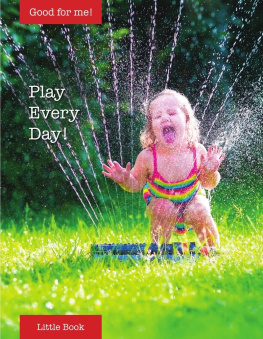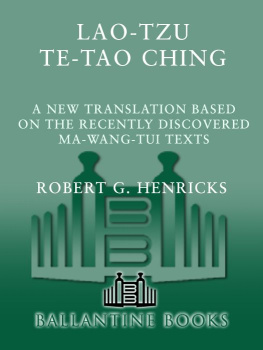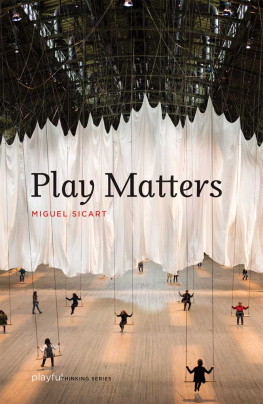PLAY AND THE HUMAN CONDITION
THOMAS S. HENRICKS
Play and the
Human Condition

2015 by the Board of Trustees
of the University of Illinois
All rights reserved
Manufactured in the United States of America
1 2 3 4 5 C P 5 4 3 2 1
 This book is printed on acid-free paper.
This book is printed on acid-free paper.
Library of Congress Cataloging-in-Publication Data
Henricks, Thomas S.
Play and the human condition / Thomas S. Henricks.
pages cm
Includes bibliographical references and index.
ISBN 978-0-252-03907-2 (cloth : alk. paper)
ISBN 978-0-252-08068-5 (pbk. : alk. paper)
ISBN 978-0-252-09705-8 (ebook)
1. PlaySocial aspects. 2. PlayPsychological aspects. 3. Self-realization.
I. Title.
HQ782.H386 2015
306.4'81dc23 2014035455
Contents
Acknowledgments
Like play itself, academic writing draws on many different resources. This is especially true for a book like this one, which features the ideas of several generations of play scholars. In addition to those writers, more proximate persons and organizations have provided support. I thank first Scott Eberle, as well as others at the American Journal of Play, for ongoing recognition of my work and belief in its possibilities. I also thank my friends and colleagues at the Association for the Study of Play for their generosity to scholars of every type and for their strong advocacy of play. I am especially indebted to David Kuschner for the many conversations we have had about play and other matters through the years. I signal the role of Jim Johnson, Fraser Brown, John Loy, and Synthia Sydnor in providing encouragement, comments, criticism, and suggestions for resources. I am grateful to administrators, librarians, and faculty at Elon University for their support, including the provision of resources for study and professional advancement. At that institution, special acknowledgment goes to Tim Peeples, Larry Basirico, Anne Bolin, Rissa Trachman, and Tom Mould. I also recognize Lisa Peloquin for our shared commitment to the themes discussed here. Some former professorsDonald Levine, Victor Lidz, Barry Schwartz, Victor Turner, and Mihaly Csikszentmihalyishould be noted. They helped legitimize the study of play and expressive culture and provided worthy models for others to follow. I salute Brian Sutton-Smith for his restless investigations of play and for his courtesy to those whose viewpoints differ from his own. I thank Laurie Matheson at the University of Illinois Press for her long-standing support of my work, as well as Jane Zanichkowsky, Jennifer Clark, Dustin Hubbart, and Katherine Jensen for their assistance in improving the manuscript and bringing it to publication. I recognize my parents, Marvin and Sylvia Henricks, for their differing models of the scholarly life. My ultimate appreciation goes to my spouse Judy Henricks and to my children Lizzie and David for their inspiring and sustaining my broader life commitments.
PLAY AND THE HUMAN CONDITION
Introduction
How do we discover who we are? How do we determine the character of the world in which we live? And how do we decide what we can do in a world so configured? Such questions, each connected to our lifelong quest for self-realization, are central to this book. Its thesis is that we learn about ourselves and the worldand about the intersection of these two realmsthrough acts of play.
To claim that play supports the development of creatures is not to make a statement that is striking or new. Indeed, play is commonly portrayed as one way in which individuals generate life strategies. When we play, we explore the limits of the possible. Ideasabout the world and about ourselvesare hoisted aloft. Pertinent skills are readied. And emotionally charged orientations, essentially judgments about what should happen next, are brought to the fore. Players are committed to making their own visions for the world happen, and on those terms they push into new territories. Each of those self-directed forays provides a range of interesting experiences to reflect on and to savor.
This general viewthat play is not just pleasing involvement in the moments of life but creative activity that has consequences for other portions of that lifehas been proposed by many scholars (see Millar 1968; Ellis 1973; Levy 1978; Spariosu 1989, 1997; Sutton-Smith 1997; Power 2005; Burghardt 2005). Many of these accounts are described in the pages that follow. Although that scholarly literature is wide-ranging, for the most part it emphasizes the significance of play for the physical and mental well-being of individuals. In other words, biological and psychological theories prevail. This emphasis is understandable, for play is frequently self-generated activity that occurs with or without companionship. And that vision of behavior is encouraged by a mythology of individualismreplete with ideas about the proper functioning, experiences, skills, and rights of personsthat is central to many contemporary societies. Such beliefs are articulated and sustained by cadres of educators, therapists, recreationalists, and healthcare providers. By such lights, play is a result of personal insight and urgency. Its benefits should be measured in the same terms.
Although this approach to play is important, there are other ways of thinking about plays character and implications. Scholars in social philosophy, folklore, anthropology, history, sociology, and other fields have argued that play is also a commentary on the lives of communities. In other words, plays causes and consequences should be seen in terms of the groups that sponsor that activity or even of society as a whole. Although most of us believe that we play just as we wish, those wishes are culturally circumscribed.
Remembering Huizingas Commitment
One of the most important statements of the second theme was presented by the cultural historian Johan Huizinga. In his book Homo Ludens: A Study of the Play Element in Culture Huizinga argues that play has social and cultural, as well as personal, implications. When people agree on the terms of their engagement with one another and collectively bring those little worlds into being, they effectively create models for living. Within those magic circles, as Huizinga (1955, p. 10) calls them, cultural themes are evaluated, dramatized, and otherwise made real. Of the many curious things that are said and done in those circumstances, some become elements of collective memory and are formalized as institutional domains. As he sees it (), [r]itual grew up in sacred play; poetry was born in play and nourished on play; music and dancing were pure play. In much the same fashion, philosophy, warfare, and the customs of noble living are founded on play patterns. What Huizinga asserts, then, is that civilization, at least in its earliest stages, is performed or played. Public play is central to the making of communities. Ideally, those play events manifest a spirit of creative, critical discourse that prepares the way for more settled styles of engagement and, within those contexts, for ongoing assessments of what has been established. Without intending to be, players are agents of change.
This introduction is not meant to criticize Huizingas ideas about the origin, maintenance, and reformation of societies (for that see Caillois 2001b; Geyl, 1963; Duncan 1988; Henricks 2002, 2006). Instead, his book is discussed for several other reasons. The first is its challenging thesis that people not only reproduce but also produce social and cultural form through acts of play. The second is its daring title.
Next page









 This book is printed on acid-free paper.
This book is printed on acid-free paper.